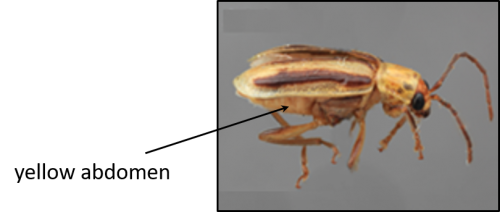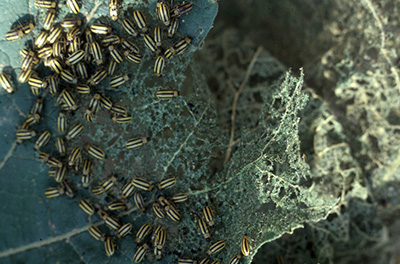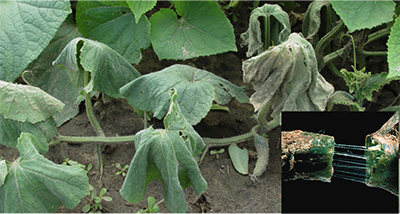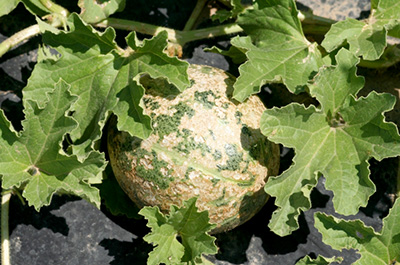Striped and spotted cucumber beetles as pests of cucurbits in Michigan
Cucumber beetles are the primary insect pest of all vine crops in Michigan.

Striped and spotted cucumber beetles attack a variety of cucurbit crops, including winter and summer squash, cucumber and watermelon. While cucumber beetle larvae feed on cucurbit roots, adult beetles cause more economically important damage. Striped cucumber beetles are specialists on cucurbits while spotted cucumber beetles feed on other plants in addition to cucurbits.
Appearance
Striped cucumber beetle adults are roughly 0.25 inch long, yellow with three black lines and a black abdomen (Photo 1). Spotted cucumber beetle adults are slightly larger, yellow or yellowish-green with 12 black spots, a black head and a yellow abdomen (Photo 2).
Larvae of both species are pale with dark heads and a dark abdomen tip, but are rarely seen because they are found in the soil. Striped cucumber beetles (Photo 3) may appear similar to the western corn rootworm, but can be distinguished by abdomen color; only striped cucumber beetles have a black abdomen. Western corn rootworm is not a pest of cucurbits.
Life cycle
Striped cucumber beetles overwinter as adults in field debris or wooded areas, emerging in April to feed and mate. Spotted cucumber beetles do not overwinter in Michigan. Adults migrate from the southern US, arriving in late June. Both species lay eggs at the base of cucurbit plants, which hatch after five to eight days. Larvae feed on crop roots for two to three weeks then pupate underground. Striped cucumber beetles have two generations per year in Michigan.

Photo 2. Adult spotted cucumber beetles can be yellow or yellow-green, have black spots and a yellow abdomen. Photo by Amanda Buchanan.

Photo 3. Western corn rootworm may be mistaken for striped cucumber beetles, but can be distinguished by its indistinct stripes and yellow abdomen. Striped cucumber beetles have more distinct stripes and a black abdomen (see Photo. 1). Photo by William Morrison III.
Damage
While cucumber beetle larvae feed on cucurbit roots, adult feeding is more damaging to the crop. Adults feed on leaves and can stunt plant growth (Photos 4 and 5). Feeding by adult cucumber beetles can spread bacterial wilt disease among cucurbit plants, even when population density is low.
Feeding on flowers can reduce fruit production, and direct feeding on fruits causes scars and pock marks, which decrease marketability of fruits (Photo 6).

Photo 4. Cucumber beetle damage on cucurbit leaves can stunt plant growth and result in the spread of bacterial wilt. Photo by Whitney Cranshaw, Colorodo State University, Bugwood.org.

Photo 5. Cucumber beetle damage on cucurbit leaves can stunt plant growth and result in the spread of bacterial wilt. Photo by Celeste Welty.

Photo 6. Cucumber beetle damage on cucurbit fruit is unattractive and decreases marketability. Photo by Whitney Cranshaw, Colorodo State University, Bugwood.org.
Management
In Michigan, scout for adults in June-August using yellow sticky cards or visual sampling.
Insecticide thresholds for cucumber beetles are one adult cucumber beetle per plant for cucurbit seedlings and five adults per plant for mature plants.
Cultural controls for cucumber beetles include removing field debris after harvest to reduce overwintering habitat and rotating crops so cucurbit crops are not planted directly into soils containing overwintering populations. Transplanting young plants rather than direct seeding can protect vulnerable seedlings from damage. Planting trap crops (cucurbit varieties highly attractive to cucumber beetles) at the perimeter of the harvested crop can keep cucumber beetles from migrating into the harvested crop.
Foliar sprays of contact pyrethroids and contact/systemic neonicotinoids, and soil drenches of neonicotinoids are common treatment options. Avoid spraying foliar contact sprays while blooms are open in the daytime. Refer to the current E0312 Midwest Vegetable Production Guide for pesticide options.
Other resources
- MSU Enviroweather – up-to-date soil temperatures and degree-days
- MSU Vegetable Entomology website
Download tip sheet version of this article: Striped and spotted cucumber beetles as pests of cucurbits in Michigan



 Print
Print Email
Email

